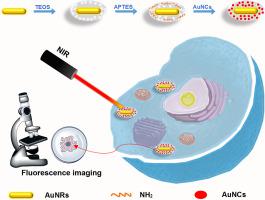Journal of Photochemistry and Photobiology B: Biology ( IF 3.9 ) Pub Date : 2020-12-26 , DOI: 10.1016/j.jphotobiol.2020.112111
Qianqian Duan , Min Yang , Boye Zhang , Yi Li , Yixia Zhang , Xiaoning Li , Jianming Wang , Wendong Zhang , Shengbo Sang

|
Photothermal therapy (PTT) is a non-invasive therapy that is widely used in cancer treatment. Gold nanorods (AuNRs) are particularly suitable as a photothermal reagent due to their unique localized surface plasmon resonance (LSPR) properties. However, bare gold nanorods are not stable enough during radiation to collect enough energy to kill tumor cells. In addition, they showed some biologically toxic originated from the poor colloidal stability and surfactants cetyltrimethyl ammonium bromide (CTAB), making it difficult to apply them directly to clinical research. To solve these problems, a novel nanocomposite was structured by coating silica shell and gold nanocluster on the outer layer of the gold nanorod (AuNRs@SiO2@AuNCs). Compared with the bare gold nanorod, the nanocomposite with the core-shell structure showed superior photothermal effect. The photothermal conversion temperature reached 63 °C under a lower irradiation power. The photothermal conversion efficiency was enhanced to 77.6%. Its photothermal performance remained constant after five cycles of near-infrared laser irradiation, indicating excellent photothermal stability. In vitro cell imaging experiments show that AuNRs@SiO2@ AuNCs can effectively enter tumor cells. By 3-(4,5-Dimethylthiazol-2-yl)-2,5-diphenyltetrazolium bromide (MTT) analysis, cancer cells can be effectively killed when exposed to a near-infrared laser. During the synthesis process, the silica and gold nanoclusters replaced the toxic CTAB molecular layer on the surface of AuNRs. Therefore, AuNRs@SiO2@AuNCs has good biocompatibility and fluorescence characteristics. These results suggest that such AuNRs@SiO2@AuNCs nanocomposite shows great potential in imaging guided photothermal therapy for cancer.
中文翻译:

金纳米团簇修饰的介孔二氧化硅涂覆的金纳米棒:增强的光热性能和荧光成像
光热疗法(PTT)是一种无创疗法,广泛用于癌症治疗。金纳米棒(AuNRs)由于其独特的局部表面等离子体共振(LSPR)特性而特别适合用作光热试剂。但是,裸露的金纳米棒在辐射期间不够稳定,无法收集足够的能量来杀死肿瘤细胞。此外,它们还显示出一些不良的胶体稳定性和表面活性剂十六烷基三甲基溴化铵(CTAB)引起的生物毒性,因此很难将其直接用于临床研究。为了解决这些问题,通过在金纳米棒(AuNRs @ SiO 2)的外层上涂覆二氧化硅壳和金纳米团簇来构造一种新型的纳米复合材料。@AuNCs)。与裸金纳米棒相比,具有核壳结构的纳米复合材料表现出优异的光热效应。在较低的照射功率下,光热转化温度达到63℃。光热转化效率提高到77.6%。经过近五个周期的近红外激光辐照后,其光热性能保持恒定,表明具有出色的光热稳定性。体外细胞成像实验表明,AuNRs @ SiO 2AuNCs可以有效地进入肿瘤细胞。通过3-(4,5-二甲基噻唑-2-基)-2,5-二苯基四唑溴化物(MTT)分析,当暴露于近红外激光时,癌细胞可以被有效杀死。在合成过程中,二氧化硅和金纳米簇取代了AuNRs表面上的有毒CTAB分子层。因此,AuNRs @ SiO 2 @AuNCs具有良好的生物相容性和荧光特性。这些结果表明,这种AuNRs @ SiO 2 @AuNCs纳米复合材料在成像指导的光热治疗癌症中显示出巨大的潜力。

































 京公网安备 11010802027423号
京公网安备 11010802027423号